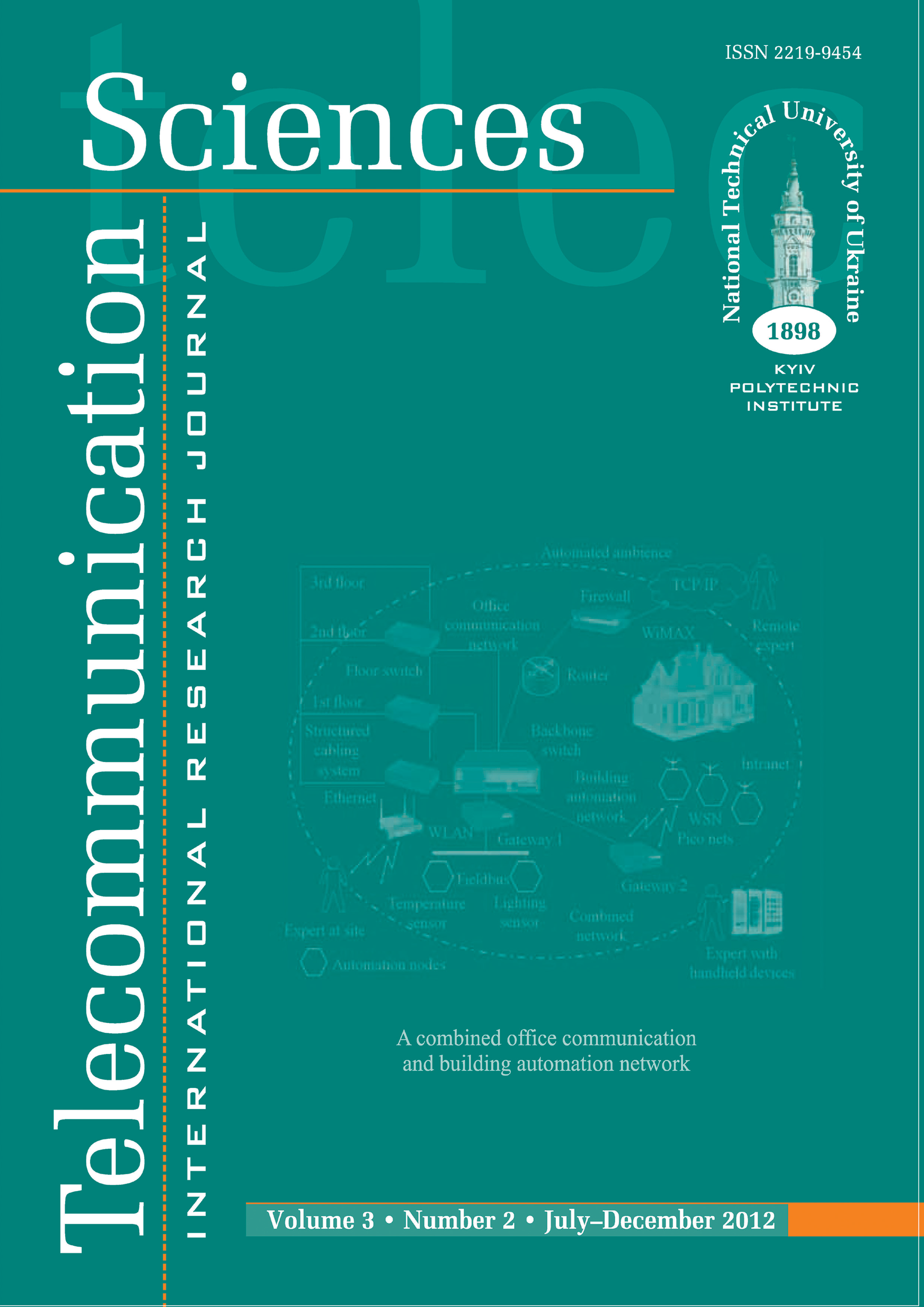WIDEBAND MATCHING THE DUAL FREQUENCY COAXIAL WAVEGUIDE FEED
DOI:
https://doi.org/10.20535/2411-2976.22012.%25pAbstract
An effective technique to the design of dual band coaxial waveguide feed horn for reflector antenna excitation has been devel-oped and tested. Matching the feed horn with free space in upper frequency range is achieved by dielectric insert disposed in-side the circular waveguide fabricated in interior conductor of open ended coaxial waveguide. The presence of dielectric insert causes the high level of reflection in lower frequency range from the boundary between the open end of coaxial waveguide and free space. A novel technical solution of highly complicated matching problem has been proposed. The matching design was performed as the series of finite thickness diaphragm arranged on outer surface of interior conductor of coaxial waveguide. To obtain the rigorous solution of given electromagnetic problem for the complicated structure consisting of a great number of connected coaxial waveguide sections and dielectric insert, a new effective approach has been proposed. The distinctive fea-ture of this approach consists in combination of rigorous procedure based on computation of generalized scattering matrices and another rigorous procedure based on the finite difference time domain method. To combine these essentially different ap-proaches, the metallic discontinuity equivalent to overall investigated structure was employed. An optimization of equivalent matching structure has been performed by the variant of the evolution strategy method. The obtained design with metallic dis-continuities was converted into real structure comprising the dielectric insert. The final calculations of real structure were per-formed by the finite difference time domain method. The effectiveness of proposed technique was confirmed by the results of testing the developed feed horn in reflector antenna system.References
Young-Bae J., Soon-Young E. Dual-band horn array design using a helical exciter for mobile satellite communication terminals // IEEE Transitions on Antennas and Propagation. - 2012. - Vol 60, N. 3. ─ P. 1336-1342
Olszewska M., Gwarek W. A dual reflector antenna for point-to-point system applications // Proceedings of 8th In-ternational Conference on Microwaves, Radar and Wireless Communications. ─ Vilnius, Lithuania, June 2010. ─ A1-4. ─ P. 27─30
Zhang Q. A coaxial corrugated dual-band horn feed // Antennas and Wireless Propagation Letters. ─ 2009. ─ Vol. 8, N. 12. ─ P. 1357─1359.
Compact dual-band axially corrugated profiled horn for prime-focus reflector antenna / R. C. Gupta, J. Pandya, K. K. Sood, R. Jyoti // International Journal of Microwave and Wireless Technologies. ─ 2011. ─ Vol. 3, N. 4. ─ P. 493 ─496.
Computer techniques for electromagnetics / Edited by R. Mittra. ─ N. Y.: Pergamon Press, 1973. ─ 488 p.
Stepanenko P. Ya. Scattering matrices of longitudinally complicated waveguide structures // Telecommunication Sciences. ─ 2011. ─ Vol. 2, N. 2. ─ P. 46─56.
Schmiedel H. Anwendung der Evolutionsoptimierung auf Schaltungen der Nachrichtentechnik // Frequenz. ─ 1981. ─ Vol. 35, N. 11. ─ p. 306─310.
E-plane integrated parallel-strip screen waveguide fil-ters / F. Arndt, J. Beike, D. Grauerholz, C. Lingemann, J. Bornemann // IEEE Transactions on Microwave Theory and Techniques. ─ 1985. ─ Vol. 33, N. 7. ─ P.654─659.
Dittloff F., Arndt F. Computer-aided design of slit-coupled H-plane T-junction diplexers with E-plane metal-insert filters // IEEE Transactions on Microwave Theory and Techniques. ─ 1988. ─ Vol. 36, N. 12. ─ P. 1833─1840.
Amari S., Bornemann J., Vahldieck R. Fast and accu-rate analysis of waveguide filters by the coupled integral equations technique // IEEE Transactions on Microwave Theory and Techniques. ─ 1997. ─ Vol. 45, N. 9. ─ P. 1611─1618.
Gradshteyn I. S., Ryzhik J. M. Tables of integrals, se-ries, and products. ─ Academic Press, 2007. ─ 1172 p.
Downloads
How to Cite
Issue
Section
License
The ownership of copyright remains with the Authors.
Authors may use their own material in other publications provided that the Journal is acknowledged as the original place of publication and National Technical University of Ukraine “Igor Sikorsky Kyiv Polytechnic Institute” as the Publisher.
ITS articles are published under Creative Commons licence:
- Authors retain copyright and grant the journal right of first publication with the work simultaneously licensed under CC BY 4.0that allows others to share the work with an acknowledgement of the work's authorship and initial publication in this journal.
- Authors are able to enter into separate, additional contractual arrangements for the non-exclusive distribution of the journal's published version of the work (e.g., post it to an institutional repository or publish it in a book), with an acknowledgement of its initial publication in this journal.
- Authors are permitted and encouraged to post their work online (e.g., in institutional repositories or on their website) prior to and during the submission process, as it can lead to productive exchanges, as well as earlier and greater citation of published work.

